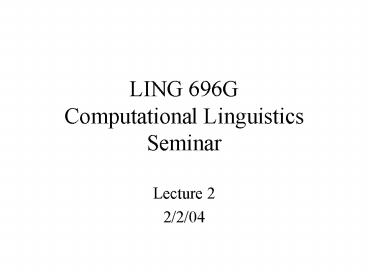LING 696G Computational Linguistics Seminar - PowerPoint PPT Presentation
Title:
LING 696G Computational Linguistics Seminar
Description:
LING 696G Computational Linguistics Seminar Lecture 2 2/2/04 Administrivia No meeting next Monday (2/09) The PAPPI System PAPPI: Principles-and-Parameters Parser ... – PowerPoint PPT presentation
Number of Views:67
Avg rating:3.0/5.0
Title: LING 696G Computational Linguistics Seminar
1
LING 696GComputational Linguistics Seminar
- Lecture 2
- 2/2/04
2
Administrivia
- No meeting next Monday (2/09)
3
The PAPPI System
- PAPPI
- Principles-and-Parameters Parser Interface
- (real demo this time)
4
Outline
- General Introduction
- What is a Parser?
- The Principles-and-Parameters Framework
Government-and-Binding Theory - Introduction to the PAPPI System
- User Interface
- Debugging
- Project Scope
5
Outline
- Architecture Overview
- Components
- Simple Morphology
- Recovery of Phrase Structure
- Recovery of Movement Determination of chain
features - Free Indexation
- Conditions on Trees and Domains
6
Outline
- General Introduction
- What is a Parser?
- The Principles-and-Parameters Framework
Government-and-Binding Theory - Introduction to the PAPPI System
- User Interface
- Debugging
- Project Scope
7
What is a Parser?
8
Immediate Issues
- Parser Knowledge
- Grammar
- Which linguistic theory?
- How to produce LDs?
- Which parsing algorithm?
- Other Issues
- Language Parameterization?
- Software viewpoint
- How do we re-use subcomponents of grammar for
other languages? - Linguistic theory viewpoint
- Re-use for other language gt supporting evidence
for principle or module - Lexical representation?
9
Principles-and-Parameters Framework
- Government-and-Binding Theory
- Lectures on Government and Binding (LGB)
(Chomsky, 1981) - A Course In GB Syntax (Lasnik Uriagereka) MIT
Press - Good introduction
10
Levels of Representation
- D-structure
- Basic structure
- S-structure
- visible movement, e.g. passivization,
wh-movement, raising - LF
- Quantifier scope, covert wh-movement
11
Levels of Representation
- Parsing Issues
- Recovery of empty categories
- Recovery of hidden levels of representation
- Relation between levels re-creation of movement
- Computational complexity
12
Outline
- General Introduction
- What is a Parser?
- The Principles-and-Parameters Framework
Government-and-Binding Theory - Introduction to the PAPPI System
- User Interface
- Debugging
- Project Scope
13
Interface
14
(No Transcript)
15
Project Scope
- English
- Classic GB A Course in GB Syntax, Lasnik
Uriagereka - Plug-ins VPS, Double Objects (Ch5) Zero Syntax
Pesetsky - Japanese
- On the Nature of Proper Government, (Lasnik
Saito), Head-final, pro-Drop, LF Wh-movement - Scrambling Some Asymmetries in Japanese...
(Saito 85) - On Long-Distance Scrambling (Saito 92). WCO,
A/A-bar distinction, Binding - Kanda Project o/ni-causatives, Double-o
constraint, Anti-superiority...
16
Project Scope
- Dutch
- V2 (also German), VR, Rightwards clausal
extraposition. - French
- Verb Movement, UG, and the Structure of IP,
Pollock. Clitics (also Spanish) - Korean
- Scrambling as Case-Driven Obligatory Movement,
(Ch2) Lee, Reconstruction - Turkish, Hungarian
- Basic sentence structure, morphology, causatives.
- Arabic
- VSO/SVO weak/strong verb agreement features
17
Outline
- Architecture Overview
- Components
- Simple Morphology
- Recovery of Phrase Structure
- Recovery of Movement Determination of chain
features - Free Indexation
- Conditions on Trees and Domains
18
Architecture
19
Architecture
20
Architecture
- Salient Points
- Avoid hardwiring
- Logic-based inference engine
- Unification. Choice points single thread,
parallel - Abstraction
- conditions on trees, features, domains
- Direct interpretation infeasible.
- Specialization permits re-targeting
- Sicstus Prolog (native fastcode) port factor of
0.425
21
Architecture
22
Outline
- Architecture Overview
- Components
- Simple Morphology
- Recovery of Phrase Structure
- Recovery of Movement Determination of chain
features - Free Indexation
- Conditions on Trees and Domains
23
Simple Morphology Features and Markers
24
(No Transcript)
25
(No Transcript)
26
(No Transcript)
27
(No Transcript)
28
Recovery of Phrase Structure
- X-bar X0-Movement Rules
- rule XP -gt XBspec(XB) ordered specFinal st
max(XP), proj(XB,XP). - rule XB -gt Xcompl(X) ordered headInitial(X) st
bar(XB), proj(X,XB), head(X). - rule v(V) moves_to i provided agr(strong),
finite(V). - rule v(V) moves_to i provided agr(weak), V
has_feature aux.
29
Recovery of Phrase StructureBacktracking
Canonical LR(1)-based Shift/Reduce Parser
30
Recovery of Phrase Structure Other Constraints
31
Phrase Structure After Chain Formation
32
Recovery of MovementComputation of Chain
Features
33
Recovery of MovementComplexity
34
Phrase Structure after Free Indexation
35
(No Transcript)
36
(No Transcript)































